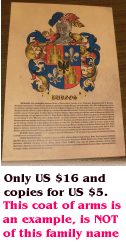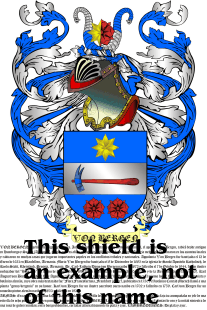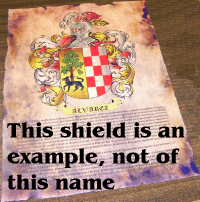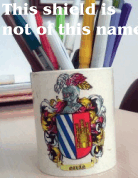
Parchment with the coat of arms, origin and history for the family name Monomakh. Very cheap.

Coat of arms for Monomakh and the history and origin for the family name Monomakh in JPG or Vectorial files as Corel-Draw, AI, WMF, etc.
The history and heraldry of the family name Monomakh appears in the Obschii Gerbobnik Dvorianskikh Rodov Vserossiiskoi (Russian Heraldry and Nobility), a magnificent book of heraldry and history of Russian noble family names, such as name Monomakh, translated to English. This work was published by the Russian government in series from the year 1797 to 1840 and contains 2,198 surnames with its history and heraldic shield, among which is the family name Monomakh. Heraldry appeared in Russia later than in Western Europe; It is generally accepted that it was copied from the west since the late seventeenth century. In the year 1722 the Emperor Peter I the Great established an Official Heraldry leaded by a Master of Heraldry under the jurisdiction of the Russian Senate. The first Vice-Master of Russian heraldry was an Italian. Under the Emperor Paul (1796-1801), since 1797 and for many decades, the Russian government accepted and published all the heraldic coats of arms nad family crests accepted and recognized. Not all the families collaborated in the registry, so there are more weapons in Russian heraldry than those collected in this work. Yes the family of the last name collaborated Monomakh.
One of the most distinctive qualities of heraldry is the use of a limited palette of colours and patterns, usually referred to as tinctures. These are divided into three categories, known as metals, colours, and furs.
Next we are going to see the meanings of three tinctures:
1) PURPLE: Justice, Wit, Truth, Greatness, Wisdom and Love; those who wear this color are obliged to defend the Prince defending ecclesiastical people.
2) OR (Gold): Nobility, Magnanimity, Wealth, Power, Light, Constancy and Wisdom.
3) SABLE: Black color that symbolizes Prudence, Sadness, Rigor, Honesty and Obedience.
Next lets look at the characteristics of some figures that we can find in heraldry and crests:
* STAR: The Stars symbolize Constancy in the service to the Sovereign in the jobs of Minister or Counselor.
* borduraNOusar: La Bordura simboliza Protección, Favor y Recompensa; asimismo la cota que vestían los caballeros y que al salir de la pelea, ostentándola manchada de sangre enemiga, eran premiados con el añadido de la bordura de escudo, como insignia de Valor.
* ANGIO: The Chief of Angio, belonging to Italian heraldry, represents a political alliance with the Welf party (derived from Welf, Duke of Bavaria) who were loyal to the Pope.
* TURTLE: The Turtle is one of the most noble figures, being a symbol of the Knight who retires late from combat, facing his enemy until the last moment, trusting in his own strength.
* WOLF: The Wolf is a symbol of a Constant Heart that suffers the calamities of war and siege with generous spirit; but when the time comes to fight in the open field, he fiercely fights, without giving his enemy a barracks.
* STAG: The Stag symbolizes Effortless Courage, which draws and recovers energy even on the most adverse occasions.
* ANCHOR: The Anchor is a symbol of Hope, it also means security and constancy, even in the greatest setbacks of fortune.
* TIGER: The Tiger represents Fierceness and Valour; Resentment; Dangerous if aroused.
* The family name Monomakh appears in the list of last names of Heraldry & Crests so its complete history, crest and coat of arms or heraldic shields can be known on his website: http://www.heraldrycrests.com/
Heraldry for family name Monomakh as well as its history is at your disposal here: Heraldry, history, origin, crest and coat of arms of the family name Monomakh
Related Words: Monomakh family crest | Origin of the name Monomakh | Genealogy of the family Monomakh | Heraldry of the name Monomakh | Coat of arms of Monomakh | Genealogy of the Monomakh | Origin of the Monomakh | Meaning of the name Monomakh.

All the information about the surnames that are collected in this web site are based on verified bibliography.
Origin of family name, history and coat of arms/crests

